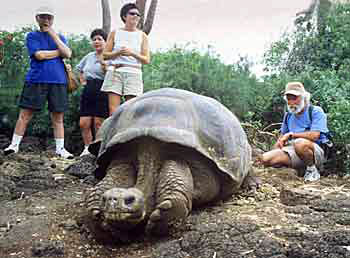|
 |
 |
From The California Native Newsletter:
Darwin Visits the Galapagos By
Ellen Klein By
Ellen Klein “I have called this principle, by which each slight variation, if useful, is preserved, by the term Natural Selection...I see no good reason why the views given in this volume should shock the religious feelings of any one.” On the Origin of Species, Charles Darwin “The date was September 15, 1835, when the lookout on the HMS Beagle sighted the archipelago known as the Galapagos Islands, and its soon-to-be-famous passenger, Charles Darwin, got his first glimpse of the lands that would later be the key to his theories of evolution. A curious child growing up in a wealthy English family, Charles Darwin (grandson of china-maker Josiah Wedgewood) was interested in science and nature, collecting beetles as a hobby. He studied medicine at Edinburgh University, but later had a change of heart, moving to Cambridge to take up theology. There he became friends with the Reverend Professor John Stevens Henslow, a clergyman and naturalist, who renewed his interest in nature. Darwin later described his friendship with Henslow as the most important circumstance in his career. Captain Robert Fitzroy (an illegitimate descendant of King Charles II), of the HMS Beagle, wanted a geologist to accompany him on his upcoming voyage to Tierra del Fuego, to study the land as he researched the sea. He initially offered the position to Henslow, whose wife persuaded him to decline. As a substitute, Henslow recommended his protegé Darwin, then twenty years old, for the job. Despite his father’s skepticism, Charles sailed with Fitzroy in 1831, and after four years of sailing around the world, collecting specimens and studying flora, fauna, and fossils, they arrived in the Galapagos. They first landed on Chatham Island (now San Cristobal), where Darwin was impressed by the tameness of the birds, and by the marine iguanas, which were ugly creatures on land, but swam with great grace. He also encountered the magnificent giant tortoises, which were gathered and taken aboard for both study and food. On Charles Island, now known as Floreana, Darwin met the governor, who claimed that he could identify the island origin of any tortoise by the shape of its shell. This idea intrigued Darwin, who would later realize the great significance of this claim. Of particular interest to Darwin was the fact that all of these species existed at all on these islands, and how and why they differed from similar species on the mainland. He was fascinated by the subtle but definite differences in the same species between one island and another. Among the birds, especially, he discovered over 13 species of finch, each slightly different from the other by the size and shape of the bill, each group having adapted to it specialized environment. These are still known today as “Darwin’s Finches.” Returning to England in 1836, he began to organize his research and meticulous notes. Over time, he realized that the differences within the species must stem from the need to survive in their unique environment, and arrived at the principle of “natural selection.” Keeping his theories mostly to himself, he spent the next 20 years gathering and studying more evidence, and then set it all down on paper. His groundbreaking book, On The Origin of the Species, was released on November 22, 1859, and sold out that day. Following this, the Galapagos were invaded by scientific expeditions collecting specimens for research and almost obliterating the tortoises. Today, the scientific community is dedicated to preserving what remains of the original species on the islands. The Galapagos National Park was established in 1959 for conservation and preservation of the Islands. Visitors to the Charles Darwin Research Center, on Santa Cruz Island, can observe the great work being done to preserve what remains of the giant tortoise populations, and can participate in the effort to preserve the ongoing history of the islands, their animals, and their continued evolution. Click Here for information on our Galapagos Tours. |
|
